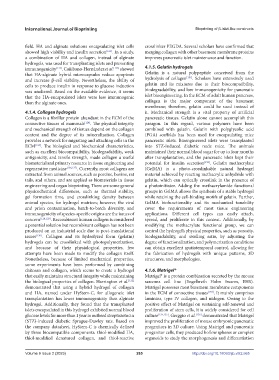Page 273 - IJB-9-2
P. 273
International Journal of Bioprinting Bioprinting of β-islet-like constructs
field. HA and alginate solutions encapsulating islet cells crosslinker PEGDA. Several scholars have confirmed that
showed high viability and insulin secretion [121] . In a study, merging collagen with other basement membrane proteins
a combination of HA and collagen, instead of alginate improves pancreatic islet maintenance and function.
hydrogels, was used for transplanting islets and preventing
immunogenicity [122] . Cañibano-Hernández et al. [123] showed 4.1.5. Gelatin hydrogels
that HA-alginate hybrid microcapsules reduce apoptosis Gelatin is a natural polypeptide conceived from the
[131]
and increase β-cell viability. Nevertheless, the ability of hydrolysis of collagen . Scholars have extensively used
cells to produce insulin in response to glucose induction gelatin and its mixtures due to their biocompatibility,
was unaltered. Based on the available evidence, it seems biodegradability, and low immunogenicity for pancreatic
that the HA-encapsulated islets were less immunogenic islet bioengineering. In the ECM of adult human pancreas,
than the alginate ones. collagen is the major component of the basement
membrane; therefore, gelatin could be used instead of
4.1.4. Collagen hydrogels it. Mechanical strength is a vital property of artificial
Collagen is a fibrillar protein abundant in the ECM of the pancreatic tissues. Gelatin alone cannot accomplish this
connective tissues of mammals [124] . The physical integrity paragon. In this regard, various polymers have been
and mechanical strength of tissues depend on the collagen combined with gelatin. Gelatin with polyglycolic acid
content and the degree of its mineralization. Collagen (PGA) scaffolds has been used for encapsulating mice
provides a network for migrating and attaching cells in the pancreatic islets. Bioengineered islets were transplanted
ECM [125] . The biological and biochemical characteristics, into STZ-induced diabetic nude mice. The animals
such as excellent biocompatibility, biodegradability, weak maintained their normal blood sugar for up to four months
antigenicity, and tensile strength, made collagen a useful after transplantation, and the pancreatic islets kept their
biomaterial and primary resource in tissue engineering and potential for insulin secretion [132] . Gelatin methacrylate
regenerative medicine [126,127] . Currently, most collagens are (GelMA) is a photo-crosslinkable natural hydrogel
extracted from animal sources, such as porcine, bovine, rat material achieved by reacting methacrylic anhydride with
tails, and others, and are applied as biomaterials in tissue gelatin, which can optically crosslink in the presence of
engineering and organ bioprinting. There are some general a photoinitiator. Adding the methacrylamide functional
physicochemical differences, such as thermal stability, groups in GelMA allows the synthesis of a stable hydrogel
gel formation time, and crosslinking density between while retaining the cell-binding motifs of gelatin. Further,
animal species, for hydrogel matrices; however, the viral GelMA biofunctionality and its mechanical tunability
and prion contamination, batch-to-batch diversity, and cover the requirements of most tissue engineering
immunogenicity of species-specific origins are the issues of applications. Different cell types can easily attach,
concern [128,129] . Recombinant human collagen is considered spread, and proliferate in this context. Additionally, by
a potential solution but recombinant collagen has not been modifying the methacrylate functional group, we can
produced on an industrial scale due to post-translational control the hydrogel’s physical properties, such as porosity,
issues [130] . Collagen and its hydrolyzed form (gelatin) biodegradability, and swelling ratio, by adjusting the
hydrogels can be crosslinked with photopolymerization, degree of functionalization, and polymerization conditions
and because of their physiological properties, few can obtain excellent spatiotemporal control, allowing for
attempts have been made to modify the collagen itself. the fabrication of hydrogels with unique patterns, 3D
Nonetheless, because of limited mechanical properties, structures, and morphologies.
some experiments have been performed by combining
chitosan and collagen, which seems to create a hydrogel 4.1.6. Matrigel®
that easily maintains structural integrity while maintaining Matrigel® is a protein combination secreted by the mouse
the biological properties of collagen. Harrington et al. [122] sarcoma cell line (Engelbreth Holm Swarm, EHS).
demonstrated that using a hybrid hydrogel of collagen Matrigel possesses most basement membrane components
and HA, named under HyStem-C, for allogeneic islet in the ECM of connective tissues [133] . It mainly comprises
transplantation has lower immunogenicity than alginate laminins, type IV collagen, and nidogen. Owing to the
hydrogel. Additionally, they found that the transplanted positive effect of Matrigel on sustaining self-renewal and
islets encapsulated in this hydrogel exhibited normal blood proliferation of stem cells, it is widely considered for cell
glucose levels for more than 1 year in outbred streptozotocin culture [134,135] . Gerggio et al. [136] demonstrated that Matrigel
(STZ)-induced diabetic Sprague-Dawley rats. Based on improved the proliferation of mouse embryonic pancreatic
the company datasheet, HyStem-C is chemically defined progenitors in 3D culture. Using Matrigel and pancreatic
by three biocompatible components: thiol-modified HA, progenitor cells, they produced hollow spheres or complex
thiol-modified denatured collagen, and thiol-reactive organoids to study the morphogenesis and differentiation
Volume 9 Issue 2 (2023) 265 http://doi.org/10.18063/ijb.v9i2.665

